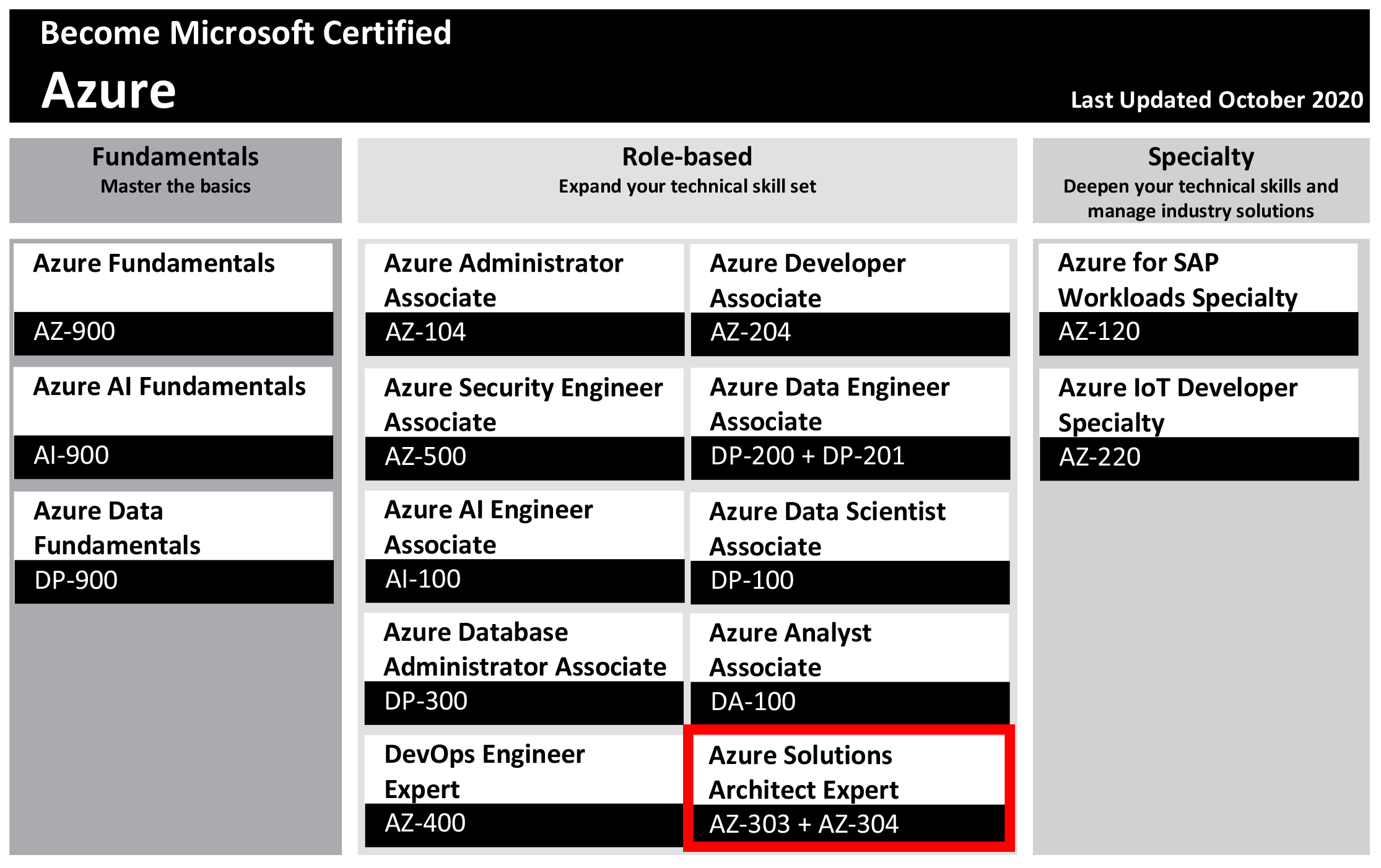Menu
AZ-303-304 - Microsoft Certified: Azure Solutions Architect Expert
Microsoft cours officiels
Home » ISEIG Cours » AZ-303-304 – Microsoft Certified: Azure Solutions Architect Expert
Ces cours sont dispensés en français sur la base d'une documentation pédagogique en anglais.
These 2 courses of respectively 5 and 4 days are designed for IT Professionals who will learn about how to manage their Azure resources, including deployment and configuration of virtual machines, virtual networks, storage accounts, and Azure AD that includes implementing and managing hybrid identities.
These courses help prepare for the exams « AZ-303 - Microsoft Azure Achitect Technologies » and « AZ-304: Microsoft Azure Architect Design » to obtain the title « Microsoft Certified: Azure Solutions Architect Expert ».
These 2 courses of respectively 5 and 4 days are designed for IT Professionals who will learn about how to manage their Azure resources, including deployment and configuration of virtual machines, virtual networks, storage accounts, and Azure AD that includes implementing and managing hybrid identities.
These courses help prepare for the exams « AZ-303 - Microsoft Azure Achitect Technologies » and « AZ-304: Microsoft Azure Architect Design » to obtain the title « Microsoft Certified: Azure Solutions Architect Expert ».

Modules et dates
These 2 courses of of respectably 5 and 4 days are given once a semester, 1 to 2 days a week, from 9:00 am to 12:00 pm and from 1:30 pm to 5:00 pm.
AZ-303 - Microsoft Azure Architect Technologies
Durée
5
Prix
CHF 3'750.-
Prix/j.
CHF 750.-
Cycle 1
11, 18, 25 oct, 1, 8 nov 2022
AZ-304 - Microsoft Azure Architect Design
Durée
4
Prix
CHF 3'000.-
Prix/j.
CHF 750.-
Cycle 1
15, 22, 29 nov, 6 déc 2022
AZ-303 - Microsoft Azure Architect Technologies
Durée
5
Prix
CHF 3'750.-
Prix/j.
CHF 750.-
Cycle 2
9, 16, 23 fév, 2, 9 mar 2023
AZ-304 - Microsoft Azure Architect Design
Durée
4
Prix
CHF 3'000.-
Prix/j.
CHF 750.-
Cycle 2
16, 23, 30 mar, 6 avr 2023
These courses are given in French on the basis of documentation in French if available (Fra) or in English (Eng). If it is available in both languages, the French version is distributed unless specifically requested by the interested party. The price of the course includes all the pedagogical documentation distributed.
AZ-303 - Microsoft Azure Architect Technologies
Overview
This course teaches Solutions Architects how to translate business requirements into secure, scalable, and reliable solutions. Lessons include virtualization, automation, networking, storage, identity, security, data platform, and application infrastructure. This course outlines how decisions in each theses area affects an overall solution. Topics include: implementing VMs for Windows and Linux, managing workloads in Azure, configuring and managing Azure Active Directory, load balancing, network security, storage account, Azure governance, hybrid identities, application infrastructure, and managing container-based applications. Students will learn through a mix of live demonstrations and hands-on lab activities. Because this course is the first course in the series for the Azure Solutions Architect exams, there is a sizeable amount of introductory content presented to prepare students for the remaining courses in the curriculum. Students are provided with a lesson that covers tips and tricks for working in the Azure portal, as well as an introduction to key tools used in the Azure environment, such as the Cloud Shell and Resource Explorer. Some emphasis is focused on the command line interface (CLI) as important skills to acquire not only in preparation for the exam but for the job role itself.
Target Audience :
- IT Professionals with expertise in designing and implementing solutions running on Microsoft Azure
Objectives :
After completing this course, students will be able to:
- secure identities with Azure Active Directory and users and groups
- implement identity solutions spanning on-premises and cloud-based capabilities
- Apply monitoring solutions for collecting, combining, and analyzing data from different sources
- manage subscriptions, accounts, Azure policies, and Role-Based Access Control
- administer Azure using the Resource Manager, Azure portal, Cloud Shell, and CLI
- configure intersite connectivity solutions like VNet Peering, and virtual network gateways
- administer Azure App Service, Azure Container Instances, and Kubernetes
Prerequisites :
Prior to taking this course, it is recommended that:
- students have passed the Azure Administrator (AZ-103) exam.
- broad knowledge of IT operations, including networking, virtualization, identity, security, business continuity, disaster recovery, data platform, budgeting, and governance
- expert-level skills in Azure administration and have experience with Azure development processes and DevOps processes
Program :
This course is composed of 15 modules including lessons and practical work (lab).
- Implement Azure Active Directory
- Implement and Manage Hybrid Identities
- Implement Virtual Networking
- Implement VMs for Windows and Linux
- Implement Load Balancing and Network Security
- Implement Storage Accounts
- Implement NoSQL Databases
- Implement Azure SQL Databases
- Automate Deployment and Configuration of Resources
- Implement and Manage Azure Governance
- Manage Security for Applications
- Manage Workloads in Azure
- Implement Container-Based Applications
- Implement an Application Infrastructure
- Implement Cloud Infrastructure Monitoring
Module 1: Implement Azure Active Directory
In this module, you will learn how to secure identities with Azure Active Directory, and implement users and groups.
Lessons
In this module, you will learn how to install and configure Azure AD Connect and implement Azure AD Connect Health.
Lessons
In this module, you will learn about basic virtual networking concepts like virtual networks and subnetting, IP addressing, network security groups, Azure Firewall, and Azure DNS.
Lessons
In this module, you will learn about Azure virtual machines including planning, creating, availability and extensions.
Lessons
In this module, you will learn about network traffic strategies including network routing and service endpoints, Azure Load Balancer, Azure Application Gateway, and Traffic Manager.
Lessons
In this module, you will learn about basic storage features including storage accounts, blob storage, Azure files and File Sync, storage security, and storage tools.
Lessons
In this module, you will learn about Azure Table Storage and recommend options for CosmsoDB APIs.
Lessons
In this module, you will create an Azure SQL Database single database, create an Azure SQL Database Managed Instance, and review high-availability and Azure SQL database.
Lessons
In this module, you will learn about the tools an Azure Administrator uses to manage their infrastructure. This includes the Azure Portal, Cloud Shell, Azure PowerShell, CLI, and Resource Manager Templates.
Lessons
In this module, you will learn about managing your subscriptions and accounts, implementing Azure policies, and using Role-Based Access Control.
Lessons
In this module, you will learn about Azure Key Vault and implementing authentication using Azure Managed Identities.
Lessons
In this module, you will learn how to migrate workloads using Azure Migrate, perform VMware agent-based and agent-less migrations, and perform Azure Backup and Azure Site Recovery.
Lessons
In this module, you will learn how to run Azure Container instances and how to deploy Kubernetes with AKS.
Lessons
In this module, you will learn how to create an App Service web App for Containers, create and configure an App Service Plan, and create and manage Deployment Slots.
Lessons
In this module, you will learn about Azure Monitor, Azure Workbooks, Azure Alerts, Network Watcher, Azure Service Health, Azure Application Insights.
Lessons
In this module, you will learn how to secure identities with Azure Active Directory, and implement users and groups.
Lessons
- Overview of Azure Active Directory
- Users and Groups
- Domains and Custom Domains
- Azure AD Identity Protection
- Implement Conditional Access
- Configure Fraud Alerts for MFA
- Implement Bypass Options
- Configure Guest Users in Azure AD
- Configure Trusted IPs
- Manage Multiple Directories
- Understand how Multiple AAD organizations interact
- Add Guest Users to Azure AD
- Configure Location Condition Configuration
- Configure Azure MFA settings
- Implement Conditional Access Azure MFA
- Create a Blueprint
In this module, you will learn how to install and configure Azure AD Connect and implement Azure AD Connect Health.
Lessons
- Install and Configure Azure AD Connect
- Configure Password Sync and Password Writeback
- Configure Azure AD Connect Health
- Implement Azure AD seamless Single Sign-On
- Perform an Azure AD Connect installation
- Implement Azure AD Connect Health
In this module, you will learn about basic virtual networking concepts like virtual networks and subnetting, IP addressing, network security groups, Azure Firewall, and Azure DNS.
Lessons
- Virtual Network Peering
- Implement VNet Peering
- Connect services with Virtual Network Peering
- Configure VNet Peering
- Understand Service Chaining
- Modify or delete VNet Peering
In this module, you will learn about Azure virtual machines including planning, creating, availability and extensions.
Lessons
- Select Virtual Machine Size
- Configure High Availability
- Implement Azure Dedicated Hosts
- Deploy and Configure Scale Sets
- Configure Azure Disk Encryption
- Plan for virtual machine implementations
- Create virtual machines
- Configure virtual machine availability, including scale sets
- Understand High Availability options for VMs in Azure
In this module, you will learn about network traffic strategies including network routing and service endpoints, Azure Load Balancer, Azure Application Gateway, and Traffic Manager.
Lessons
- Implement Azure Load Balancer
- Implement an Application Gateway
- Understand Web Application Firewall
- Implement Azure Firewall
- Implement Azure Front Door
- Implementing Azure Traffic Manager
- Implement Network Security Groups and Application Security Groups
- Implement Azure Bastion
- Describe characteristics of highly available Azure VMs residing in the same availability set
- Describe characteristics of highly available Azure VMs residing in different availability zones
- Describe characteristics of automatic horizontal scaling of Azure VM Scale Sets
- Describe characteristics of manual vertical scaling of Azure VM Scale Sets
- Select a Load Balancer solution
- Configure Application Gateway
- Implement Azure Firewall
- Create an Azure Front Door
- Understand Traffic Manager routing methods
- Configure Network Security Groups (NSGs)
In this module, you will learn about basic storage features including storage accounts, blob storage, Azure files and File Sync, storage security, and storage tools.
Lessons
- Storage Accounts
- Blob Storage
- Storage Security
- Managing Storage
- Accessing Blobs and Queues using AAD
- Implement authorization of Azure Storage blobs by leveraging shared access signatures
- Implement authorization of Azure Storage blobs by leveraging Azure Active Directory
- Implement authorization of Azure Storage file shares by leveraging access keys
- Configure Azure Storage Firewalls and Virtual Networks
- Understand Storage Account services and types
- Configure Blob storage, accounts, containers, and access tiers
- Implement Shared Access Signatures (SAS)
- Understand Azure Storage firewalls and virtual networks
In this module, you will learn about Azure Table Storage and recommend options for CosmsoDB APIs.
Lessons
- Configure Storage Account Tables
- Select Appropriate CosmosDB APIs
- Outline the Table Service Data Model
- Understand options for Azure Cosmos DB
- Understand high availability using CosmosDB
In this module, you will create an Azure SQL Database single database, create an Azure SQL Database Managed Instance, and review high-availability and Azure SQL database.
Lessons
- Configure Azure SQL Database Settings
- Implement Azure SQL Database Managed Instances
- High-Availability and Azure SQL Database In this module, you will learn how to
- Create an Azure SQL Database (single database)
- Create an Azure SQL Database Managed Instance
- Recommend high-availability architectural models used in Azure SQL Database
In this module, you will learn about the tools an Azure Administrator uses to manage their infrastructure. This includes the Azure Portal, Cloud Shell, Azure PowerShell, CLI, and Resource Manager Templates.
Lessons
- Azure Resource Manager Templates
- Save a Template for a VM
- Evaluate Location of New Resources
- Configure a Virtual Hard Disk Template
- Deploy from a template
- Create and Execute an Automation Runbook
- Leverage Azure Resource Manager to organize resources
- Use ARM Templates to deploy resources
- Create and Execute an Automation Runbook
- Deploy an Azure VM from a VHD
- Understand Azure encryption technologies
In this module, you will learn about managing your subscriptions and accounts, implementing Azure policies, and using Role-Based Access Control.
Lessons
- Create Management Groups, Subscriptions, and Resource Groups
- Overview of Role-Based Access Control (RBAC)
- Role-Based Access Control (RBAC) Roles
- Azure AD Access Reviews
- Implement and Configure an Azure Policy
- Azure Blueprints
- Implement authorization of Azure Storage blobs by leveraging shared access signatures
- Implement authorization of Azure Storage blobs by leveraging Azure Active Directory
- Implement authorization of Azure Storage file shares by leveraging access keys
- Define a custom RBAC role
- Assign a custom RBAC role
- Understand Resource Group Organization
- Understand how RBAC works
- Create an Azure AD access review
- Create and manage policies to enforce compliance
In this module, you will learn about Azure Key Vault and implementing authentication using Azure Managed Identities.
Lessons
- Azure Key Vault
- Azure Managed Identity
- Explain Key Vault uses such as secrets, key, and Certificate management
- Use Managed Identities with Azure resources
In this module, you will learn how to migrate workloads using Azure Migrate, perform VMware agent-based and agent-less migrations, and perform Azure Backup and Azure Site Recovery.
Lessons
- Migrate Workloads using Azure Migrate
- VMware – Agentless Migration
- VMware – Agent-Based Migration
- Implement Azure Backup
- Azure to Azure Site Recovery
- Implement Azure Update Management
- Configure Azure Site Recovery
- Perform test failover
- Perform planned failover
- Perform unplanned failover
- Understand agent-based migration architecture
- Prepare for Azure for migration
- Prepare an on-premises VMware environment
- Understand Azure VM backup architecture
- Manage updates and patches for Azure VMs
In this module, you will learn how to run Azure Container instances and how to deploy Kubernetes with AKS.
Lessons
- Azure Container Instances
- Configure Azure Kubernetes Service
- Run Azure Container instances
- Deploy Kubernetes with AKS
In this module, you will learn how to create an App Service web App for Containers, create and configure an App Service Plan, and create and manage Deployment Slots.
Lessons
- Create and Configure Azure App Service
- Create an App Service Web App for Containers
- Create and Configure an App Service Plan
- Configure Networking for an App Service
- Create and Manage Deployment Slots
- Implement Logic Apps
- Implement Azure Functions
- Configure and validate an Azure Function App Storage Blob trigger
- Configure and validate an Azure Event Grid subscription-based queue messaging
- Implement Blue/Green deployment pattern by using deployment slots of Azure App Service web apps
- Perform A/B testing by using deployment slots of Azure App Service web apps
- Configure an Azure App Service
- Create an App Service Plan
- Create a Workflow using Azure Logic Apps
- Create a Function App
In this module, you will learn about Azure Monitor, Azure Workbooks, Azure Alerts, Network Watcher, Azure Service Health, Azure Application Insights.
Lessons
- Azure Infrastructure Security Monitoring
- Azure Monitor
- Azure Workbooks
- Azure Alerts
- Log Analytics
- Network Watcher
- Azure Service Health
- Monitor Azure Costs
- Azure Application Insights
- Unified Monitoring in Azure
- Understand Azure Log Analytics
- Understand Azure Service Health
AZ-304 - Microsoft Azure Architect Design
Overview
This course teaches Solutions Architects how to translate business requirements into secure, scalable, and reliable designs recommendations. Lessons include monitoring, automation, data storage, and infrastructure. This course outlines how decisions in each these areas influences an overall design solution.
Target Audience :
- IT Professionals with expertise in designing and implementing solutions running on Microsoft Azure
Objectives :
After completing this course, students will be able to:
- recommend solutions to minimize costs
- recommend a solution for Conditional Access, including multi-factor authentication
- recommend a solution for a hybrid identity including Azure AD Connect and Azure AD Connect
- recommend a solution for using Azure Policy
- recommend a solution that includes KeyVault
- recommend a solution that includes Azure AD Managed Identities
- recommend a storage access solution
- design an Azure Site Recovery solution
- recommend a solution for autoscaling
- recommend a solution for containers
- recommend a solution for network security
- recommend a solution for migrating applications and VMs
- recommend a solution for migration of databases
Prerequisites :
Prior to taking this course, it is recommended that:
- students have passed the Azure Administrator (AZ-103) exam.
- broad knowledge of IT operations, including networking, virtualization, identity, security, business continuity, disaster recovery, data platform, budgeting, and governance
- expert-level skills in Azure administration and have experience with Azure development processes and DevOps processes
Program :
This course is composed of 14 modules including lessons and practical work (lab).
- Design a Compute Solution
- Design a Network Solution
- Design for Migration
- Design Authentication and Authorization
- Design Governance
- Design a Solution for Databases
- Select an Appropriate Storage Account
- Design Data Integration
- Design a Solution for Logging and Monitoring
- Design a Solution for Backup and Recovery
- Design for High Availability
- Design for Cost Optimization
- Design an Application Architecture
- Design Security for Applications
Module 1: Design a Compute Solution
In this module, you will learn about the appropriate compute technologies, including virtual machines, App Services, Service Fabric, Azure Functions, Windows Virtual Desktop, and containers.
Lessons
In this module, you will learn about solutions for network addressing and name resolution, network provisioning, and network security.
Lessons
In this module, you will learn about recommend a solution for migrating applications and VMs and a solution for migration of databases.
Lessons
In this module, you will learn how to provide Identities to services and understand the hierarchy of Management Groups and Subscriptions.
Lessons
In this module, you will learn apply an Azure Policy, Identify non-compliant resources, and manage tag governance with Azure Policy
Lessons
In this module, you will be able to recommend the appropriate data store and recommend Azure SQL Database and Azure SQL Managed Instance Service tiers.
Lessons
In this module, you will learn about recommend a design a strategy for using tiered storage and manage tiered Storage using Azure tools.
Lessons
In this module, you will learn about data flows using Azure Data Factory and Azure Synapse Analytics architecture.
Lessons
In this module, you will learn about Azure Monitor, Azure Application Insights, and Azure Sentinel. You will be able to monitor Azure Resources with Azure Monitor and collect and analyze resource Logs for Azure.using Azure tools.
Lessons
In this module, you will learn about solutions for site recovery capacity and site failover and failback. You will be able to recommend solutions for recovery in different regions.
Lessons
In this module, you will learn about solutions for application and workload redundancy, including compute, database, and storage.
Lessons
In this module, you will learn how to optimize costs from recommendations, breakdown costs by Azure Service, and download and review usage details. 01-View
Lessons
In this module, you will learn about solution for deployment of applications including ARM templates, Logic Apps, or Azure Functions. You will also learn about microservices architecture including Event Grid, Event Hubs, Service Bus, Storage Queues, Logic Apps, Azure Functions, and webhooks.
Lessons
In this module, you will learn about solution for deployment of applications including ARM templates, Logic Apps, or Azure Functions. You will also learn about microservices architecture including Event Grid, Event Hubs, Service Bus, Storage Queues, Logic Apps, Azure Functions, and webhooks.
Lessons
In this module, you will learn about the appropriate compute technologies, including virtual machines, App Services, Service Fabric, Azure Functions, Windows Virtual Desktop, and containers.
Lessons
- Recommend a Solution for Compute Provisioning
- Determine Appropriate Compute Technologies
- Recommend a Solution for Containers
- Recommend a Solution for Automating Compute Management
- Implement containers running in Azure VMs
- Deploy containers to Azure Container Instances
- Deploy containers to Azure Kubernetes Service (AKS) clusters
- Refer solution for automating compute management
- Recommend the appropriate compute technologies, including virtual machines, and App Services
- Recommend the approrioate AKS and ACI and the configurations
In this module, you will learn about solutions for network addressing and name resolution, network provisioning, and network security.
Lessons
- Recommend a Solution for Network Addressing and Name Resolution
- Recommend a Solution for Network Provisioning
- Recommend a Solution for Network Security
- Recommend a Solution for iInternete Connectivity and On-Premises Networks
- Recommend a Solution for Automating Network Management
- Recommend a Solution for Load Balancing and Rraffic Routing
- Solutions for network addressing and name resolution
- Solutions for network security including private endpoints, firewalls, and gateways
- Recommendations for network connectivity to the Internet, on-premises networks, and other VNets
- Recommendations for load balancing and traffic routing
In this module, you will learn about recommend a solution for migrating applications and VMs and a solution for migration of databases.
Lessons
- Assess and On-Premises Servers and Applications for Migration
- Recommend a Solution for Migrating Applications and VMs
- Recommend a Solution for Migration of Databases
- Assess on-premises servers and applications for migration
- Suggest solutions for migrating applications and VMs
- Determine migration scope, including redundant, related, trivial, and outdated data
In this module, you will learn how to provide Identities to services and understand the hierarchy of Management Groups and Subscriptions.
Lessons
- Tips for Identity and Access Management
- Recommend a Solution for Multi-Factor Authentication
- Five Steps for Securing Identity Infrastructure
- Recommend a Solution for Single-Sign On (SSO)
- Recommend a Solution for a Hybrid Identity
- Recommend a Solution for B2B Integration
- Recommend a Hierarchical Structure for Management Groups
- Deploy an Azure VM hosting an AD DS domain controller
- Create and configure an Azure AD tenant
- Integrate an AD DS forest with an Azure AD tenant
- Recommend hierarchy of Management Groups and Subscriptions.
- Configure custom RBAC Role definitions and assignments
- Plan for a MFA Deployment
- Recommend a Solution for Single-Sign On (SSO)
- Recommend a Solution for a Hybrid Identity
In this module, you will learn apply an Azure Policy, Identify non-compliant resources, and manage tag governance with Azure Policy
Lessons
- Recommend a Solution for using Azure Policy
- Recommend a Solution for using Azure Blueprint
- Organize Policies with Initiatives
- Manage Tag Governance with Azure Policy
- Provide guidance on Azure Blueprints
In this module, you will be able to recommend the appropriate data store and recommend Azure SQL Database and Azure SQL Managed Instance Service tiers.
Lessons
- Select an Appropriate Data Platform Based on Requirements
- Overview of Azure Data Storage
- Recommend Database Service Tier Sizing
- Dynamically Scale Azure SQL Database and Azure SQL Managed Instances
- Recommend a Solution for Encrypting Data at Rest, Transmission, and In Use
- Recommend Database Service Tier Sizing
- Recommend a Solution for Encrypting Data at Rest, Transmission, and In Use
- Understand Azure Data Lake Store and Azure Blob Storage containers
In this module, you will learn about recommend a design a strategy for using tiered storage and manage tiered Storage using Azure tools.
Lessons
- Understanding Storage Tiers
- Recommend a Storage Access Solution
- Recommend Storage Management Tools
- Recommend tools for working with Azure Storage
- Design for Azure Blob Storage access tiers
In this module, you will learn about data flows using Azure Data Factory and Azure Synapse Analytics architecture.
Lessons
- Recommend a Data Flow
- Recommend a Solution for Data Integration
- Implement Azure Synapse Analytics
- Describe how data flows using Azure Data Factory
- Demonstrate how to use Azure Data Factory to load data into SQL Data Warehouse
In this module, you will learn about Azure Monitor, Azure Application Insights, and Azure Sentinel. You will be able to monitor Azure Resources with Azure Monitor and collect and analyze resource Logs for Azure.using Azure tools.
Lessons
- Azure Monitoring Services
- Azure Monitor
- Monitor Azure resources with Azure Monitor
- Collect and analyze Resource Logs for Azure resources
- Understand how Azure Sentinel collects data on the devices, users, infrastructure, and applications
In this module, you will learn about solutions for site recovery capacity and site failover and failback. You will be able to recommend solutions for recovery in different regions.
Lessons
- Recommend a Recovery Solution for Hybrid and On-Premises Workloads
- Design and Azure Site Recovery Solution
- Recommend a Solution for Recovery in Different Regions
- Recommend a Solution for Azure Backup Management
- Design a Solution for Data Archiving and Retention
- Recommend solutions for Azure hybrid and on-premises workloads that meets recovery objectives
- Recommend a solution for site recovery capacity
- Recommend storage types and methodology for data archiving
- Identify requirements for data archiving
In this module, you will learn about solutions for application and workload redundancy, including compute, database, and storage.
Lessons
- Recommend a Solution for Application and Workload Redundancy
- Recommend a Solution for Autoscaling
- Identify Resources that Require High Availability
- Identify Storage Tpes for High Availability
- Recommend a Solution for Geo-Redundancy of Workloads
- Recommend a solutions for autoscaling
- Identify storage types for high availability
- Recommend a solutions for geo-redundancy of workloads
In this module, you will learn how to optimize costs from recommendations, breakdown costs by Azure Service, and download and review usage details. 01-View
Lessons
- Recommend Solutions for Cost Management
- Recommended Viewpoints for Minimizing Costs
- Optimize with Azure Cost Management
- Design with Cost in mind
- Optimize Costs from recommendations
In this module, you will learn about solution for deployment of applications including ARM templates, Logic Apps, or Azure Functions. You will also learn about microservices architecture including Event Grid, Event Hubs, Service Bus, Storage Queues, Logic Apps, Azure Functions, and webhooks.
Lessons
- Recommend a Microservices Architecture
- Recommend an Orchestration Solution for Deployment of Applications
- Recommend a Solution for API Integration
- Integrate Azure Logic Apps with Event Grid
- Trigger execution of Logic Apps in response to an event representing a change to a resource
- Recommend deployment solutions using ARM templates, Logic Apps, or Azure Functions
- Recommend a solution for monitoring automation
- Recommend a hosting structure for API management
In this module, you will learn about solution for deployment of applications including ARM templates, Logic Apps, or Azure Functions. You will also learn about microservices architecture including Event Grid, Event Hubs, Service Bus, Storage Queues, Logic Apps, Azure Functions, and webhooks.
Lessons
- Security for Applications and Services
- Recommend a Solution using Key Vault
- Recommend Solutions using Azure AD Managed Identities
- Understand Key Vault authentication and authorization
- Understan Azure Key Vault availability and redundancy
- Understand how Blueprints differ from Resource Manager Templates and Azure Policy





